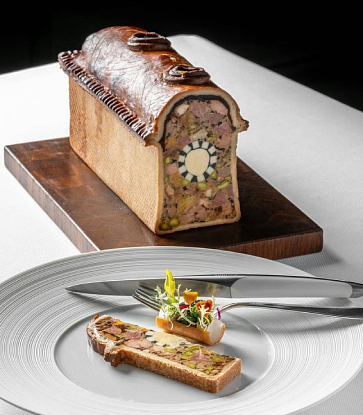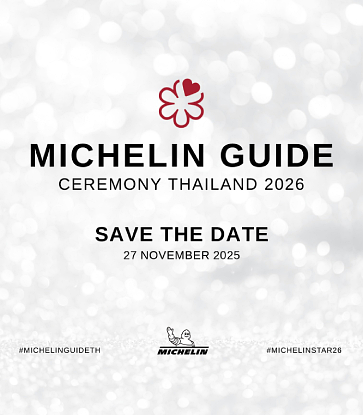Around the world, any list of famous authentic Thai dishes will invariably include tom yam kung. Its signature blend of tart, spicy, salty, and sweet notes balances perfectly for its distinct aroma from galangal, lemongrass, bergamot, and bird’s eye chillies. Together, it creates a smooth, subtle flavour that is not too sour or too hot so that diners can fully savour the tastiness, as well as the restorative benefits of the Thai herbs and spices. It has been selected as part of Thailand’s Department of Cultural Promotion’s “Thai Taste Therapy”. This global project aims to promote traditional Thai cuisine as “the world’s tastiness medicine”, as dishes like tom yam kung feature natural ingredients that are deliciously healthy.

Tom yam kung, past and present
Tom yam kung’s exact origin is not clear, but we do have evidence of a tom yam dish, mainly with fish and not shrimp, in a recipe in Ma Krua Huapa by Thanpuying Plian Phasakornwong, the first official Thai cookbook published in 1908 during King Rama V’s reign. It was called tom yam khaman (Cambodian tom yam) or kang nok mo (curry outside the pot), and it did not look like the tom yam kung that is enjoyed today.Even if its origins are unknown, tom yam kung is still a fascinating dish. There are its many variations, including clear and milky recipes, and there is the development of the dish itself, as clever cooks harnessed local flora into recipes that people would want to eat to enjoy the therapeutic benefits of Thai herbs and spices. More importantly, tom yam kung represents Thailand’s natural abundance, as in the Thai saying, “There’s fish in the water, there’s rice in the fields.” And there are herbs. All of which could be found by the kitchen. At least by the canal outside the kitchen of Chef Nooror Somany Steppe, head chef and founder of Blue Elephant Bangkok and Blue Elephant Phuket (both recommended in MICHELIN Guide Thailand 2023). She recalled her childhood memories of tom yam, when the broth was clear. No one added milk or coconut cream like they do today. But even then, tom yam was not crystal clear. The broth would have lovely pools of shrimp fat shimmering, reflecting the abundance of Thailand’s waters.

“When I was young, our house was next to a canal. If my mom caught any shrimp, she would make tom yam kung with clear broth. And no roasted chilli peppers. She would boil water and pound a little lemongrass to add. Not a lot, because she said that the shrimp didn’t smell like fish could. If you made tom yam with fish [tom yam pla], you could add more lemongrass. Then she would add a little onion and use the entire shrimp. She would put it all in, boiling the head and the shell. There was no need for stock, like people use now. Seasonings came after it was done, and she poured it out of the pot. Then she would add lime juice, fish sauce, bird’s eye chillies, and, for her own special recipe, a little sugar. She said that would make the flavours less harsh, more mellow. The sugar would help create a more balanced taste. Something people may not know is that tom yam kung recipes once emphasised lemongrass, using only a little galangal. Like the well-known Thai food master, Sisamon Kongpan. Her tom yam kung recipe calls for a tiny amount of galangal. Galangal was meant for tom yam pla to counteract any fishy smells. But nowadays, tom yam kung usually features galangal, which I think is an interesting development in its flavour profile.”
Chef Steppe went on to explain that, beyond the freshness of the shrimp, tom yam kung’s outstanding trait is its fragrance, which comes from various Thai herbs. This is part and parcel of Thai local wisdom, creating appealing meals with medicinal benefits. “When it came to opening my own restaurant, I wanted foreigners to realise the real benefits of Thai herbs. Because, really, all the herbs in tom yam kung are good for you, not just the galangal, lemongrass, and bergamot leaves that we crush or shred to add to our tom yam. I crush and pound the herbs to a very fine consistency so my customers can eat them. With large pieces of herbs, customers will enjoy the aroma, but they may not dare to eat them. But with the Blue Elephant’s tom yam kung, diners can eat the herbs and feel the benefits. Bergamot leaves help ease stress. Galangal helps relieve flatulence, indigestion, and colic. As for lemongrass, I learned from my mother since I was a child that it improves blood circulation. So, eating tom yam kung is no different than taking medicine.”
Chef Steppe then discussed the main ingredient, shrimp, explaining how, in the past, Thai kitchens used river shrimp for their tom yam kung. These crustaceans had a level of fat that would create a creamy texture without having to add milk or coconut cream, as they do today. However, river prawns have become an expensive product, because you need fresh catches for the best flavours. The alternative now is to use smaller saltwater shrimps, but they do not have the fattiness like their freshwater cousins. This is why recipes have been adapted to include milk or coconut cream to add that unctuousness. So, now we have tom yam kung nam khon (milky tom yam kung) recipes, which use roasted chilli paste more as well.
Even though tom yam kung is seen as a home-made comfort food that is also available at most Thai restaurants, Chef Steppe claimed that it is the most difficult Thai dish to make. Tom yam kung, to Chef Steppe, is a true test of a Thai chef’s skill because they must balance different flavours for a mellow, subtle dish. “Tom yam kung looks simple at first, but it is actually the most difficult, because you must balance both flavours and aromas.”

Chef Nooror Somany Steppe’s tom yam kung recipe
2 servingsFor prawn stock
Ingredients:
- 4 prawn heads and shells
- 2 crushed lemongrasses
- 2 coriander roots
- 2 crushed shallots
- 3 cups of water
Instructions:
- Bring a pot of water to boil over medium heat.
- Add shrimp heads and shells, coriander roots, crushed lemongrass, and crushed shallots. Add a little salt and turn off the heat.
For tom yam kung
Ingredients:
- 4 river prawns
- 3 cups of prawn stock
- 1 lemongrass (crushed and finely chopped)
- 2 leaves of Bergamot leaves (finely shredded by hand) 2 leaves
- 2 crushed coriander roots
- 5 crushed bird’s eye chillies
- 3 straw mushrooms (sliced lengthwise)
- 6 grams of thinly sliced galangal
- 2 leaves of coriander leaves for garnish
For seasonings
- 3 table spoons of fish sauce
- 2½ tablespoons of lime juice
- 1½ tablespoons of sugar
- 1 tablespoon of roasted chilli paste
Instructions:
- Bring stock to a boil over medium heat.
- Continue to boil, adding crushed lemongrass and coriander root.
- Add straw mushrooms, river prawns, galangal, and bergamot leaves. Season with fish sauce, sugar, and roasted chilli paste. Allow to boil a little longer.
- Turn off the heat. Add bird’s eye chillies and lime juice, and remove the coriander roots. Pour into serving bowls.
- Garnish with cilantro leaves.
Extra tips from the chef:
- Adding the lime juice after turning off the heat makes the tom yam more fragrant.
- Adding the bergamot leaves after the shrimp enhances the shrimp’s aroma.

In search of tom yam kung’s herbs
Tom yam kung is served in nearly every Thai restaurant. If you want to learn about the ingredients in this deliciously healthy recipe, we can put you on a trail of spots to visit where you can discover more:- Herb gardens around Khlong Lat Mayom Floating Market: Did you know that an important source for tom yam herbs is around Khlong Lat Mayom, Taling Chan District, in Bangkok? It is well known for its floating market full of produce and foods from the local community, but there are also traditional gardens all around the area growing tom yam ingredients like lemongrass and galangal. If you take a boat trip around the canals, you can see some of these gardens, but you can see a lot more if you explore the community by bicycle.
- Abhaibhubejhr Thai Herbal Medicine Museum: Anyone interested in learning about Thai herbs in depth should head straight to this museum located inside the Chao Phraya Abhaibhubejhr Hospital in Prachin Buri. Built in 1909, the building combines western architecture with intricate Thai designs. Today, it is a museum dedicated to preserving and educating people about Thai herbs and Thai traditional medicines.
- Ayutthaya, the land of tom yam kung: If you want to try myriad variations on tom yam kung, you should visit the province of Phra Nakhon Si Ayutthaya. Here you can find many different tom yam kung offerings, such as at Bib Gourmand restaurants like Joong Borikan; Ruanthai Kungpao, a visitor favourite; or Baan Ta Ko Rai, with its deliciously traditional tom yam kung.

Even though it seems like travelling is getting back in gear, you should still be careful and protect yourself. Wear a mask and wash your hands. And for extra confidence, look for a SHA certificate that guarantees compliance with sanitation measures. The certificate reassures every traveller concerned with their health and safety.
Learn more about this great project at thailandsha.tourismthailand.org. For updates on travel destinations, contact TAT Call Center 1672, or Facebook TAT Contact Center.





















